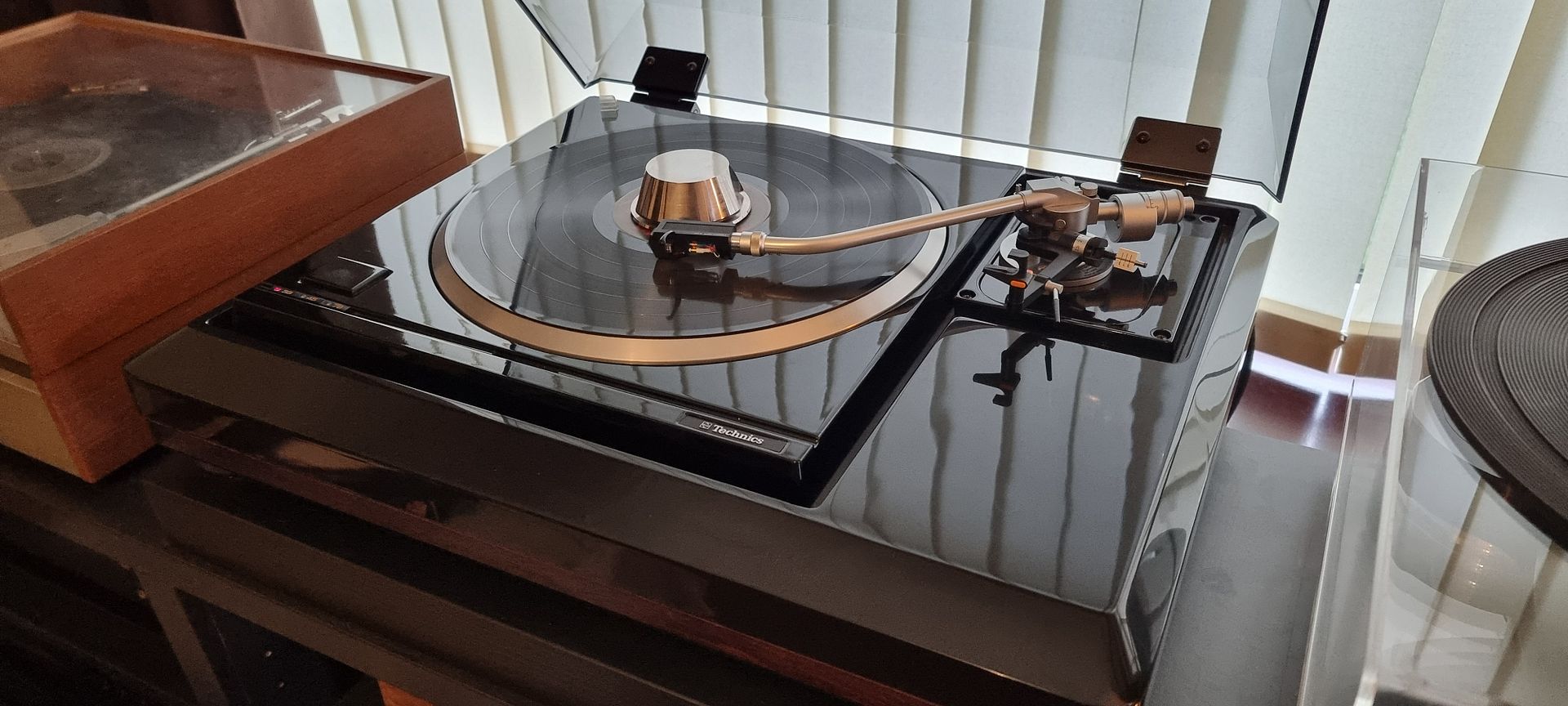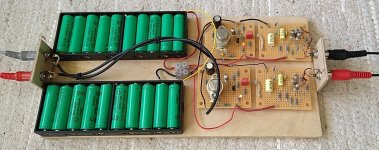Please,post a dedicated thread!My self designed and self built RIAA amp.
- MM & MC
- Adjustable load capacitance for MM and load resistance for MC
- Adjustable gain, 4 steps
- DC servo to eliminate unnecessary coupling capacitors
- Active/passive RIAA network with 0.1 % thin film resistors, 2 % PPS caps
- RIAA accuracy better than +/-0.1 dB
- Mute circuit to eliminate pops at power-up and off
- Low noise and ultra low distortion
- 4-layer PCB with good GND plane for low noise
View attachment 1172652
I recently did a couple of these and had the enclosure CNC machined:
View attachment 1172653
Example frequency response deviation (jumps at low frequecies caused by QA software settings). Note the Y-axle span.
View attachment 1172654
I may post a dedicated thread about this one if there's interest.
Risto
Thanks
I have thought about magnetically levitated platters. If totally suspended by magnetics, would there be any 'bumping' from magnet to magnet? If so, would it help to only partially suspend the platter and have say 80% of the weight suspended, allowing for a stabilization of the platter weight during rotation?
Hey eso I like your turntables but I like your lp even more!!
Is that "tanto tempo"?
Bananeira does it for me.
Cheers mate
Is that "tanto tempo"?
Bananeira does it for me.
Cheers mate
Changed the arm on the SP10, now using a PMAC AT1010 Mk8. Running a Goldring Elite MC cart


That is Tanto Tempo.Hey eso I like your turntables but I like your lp even more!!
Is that "tanto tempo"?
Bananeira does it for me.
Cheers mate
I've got a bunch of Gal Costa early releases too.
But have you heard this one?
It's great
Hi Deadhead;
I'm rereading the thread, looking hard at Adelmo's suspension. With more spare time, I'm ready to make my plinth "float". One gets tired of having to tip toe around the room!
The platter magnets are rather large compared to what's available. As to whether the force is doubled, you would have to study Earnshaw's theorem. It is significantly more than singles. What gets me, is that after a few years, it hasn't sagged any.
I see that platters are available again on ebay.com. Search for...
60T Super Sound Aluminum Platter+Tungsten steel Maglev bearing for Turntables
Cheers; Glenn
Hi Glenn,
Any progress with your TT?
Rgds
Adelmo
I should have done it already but have been too busy. I will do it in November, hopefully.Please,post a dedicated thread!
Thanks
I think my 8th or 9th DIY retip. Supex SD-909. Sounds fantastic with a Naimiki Shibatata in place. Quite a bit heavier than the SD-900 Super I retipped with a line contact ruby cantilever, and the 909 is happier with a bit more tracking force (2.1-2.3 or so right now). Now I gotta figure out how to get all the old melted yellow rubber off of the coils... I am sure that is why it's tracking heavy.
Supex
I still have an earlyZSupex (from the late 70s) hat i want to get restylused sometime. I really was impressed by it. They were very expensive. About $200 CAD for the cartridge.
dave
I finally completed the build of the HPS6.1 after the final demise of the 5.1. (See here). This is far better with the servo locking on very quickly. As I didn't have a hot air gun I elected to use the pre-tracking regulators I'd built for the previous amp rather than those the PCB is designed to use. I also recycle some of the metalwork.
It's extremely quiet, accurate, and dynamic and does justice to my high-end cartridges. It also has a very high gain in both Low and High configurations (69 and 54 dBs respectively), this could be too much for certain cartridges. I'm not sure if altering the feedback resistors to reduce such would cause an issue (excessive current in the loop for example).
Many thanks to Ovidiu for sharing this design.


It's extremely quiet, accurate, and dynamic and does justice to my high-end cartridges. It also has a very high gain in both Low and High configurations (69 and 54 dBs respectively), this could be too much for certain cartridges. I'm not sure if altering the feedback resistors to reduce such would cause an issue (excessive current in the loop for example).
Many thanks to Ovidiu for sharing this design.
Is it housed in those teak faced enclosures? ...did you make them or buy them ? If bought , where from ?
They look very handsome .
They look very handsome .
Walnut with about 6 coats of Finishing Oil. I made the enclosures from MDF spray finished in matt black while the back panels are from mild steel (see attached). If I could find a source I would like to have a badge on each box, that would give it a final touch I feel ('HPS6.1 - Phono Amp' and 'HPS6.1 - Power Supply’)

Regards,
Karl
Regards,
Karl
Last edited by a moderator:
There is a bolt in the middle of the copper link (see back panel photo) - I have zero hum.Hi Karl,
wheres your tonearm ground mounted?
Photo by Dale Roth of my Li' Pucker design.

Happy midsummer !
Here is my own design, a simple riaa amp with one j-fet, three germanium transistors and two current sources per channel.
No global NFB and passive riaa EQ. Powered by 20x 1.2V / 600mAh nimh rechargeable batteries.
This sounds similar like good tube riaa amp, of course it is not same thing ...
Here is my own design, a simple riaa amp with one j-fet, three germanium transistors and two current sources per channel.
No global NFB and passive riaa EQ. Powered by 20x 1.2V / 600mAh nimh rechargeable batteries.
This sounds similar like good tube riaa amp, of course it is not same thing ...
Attachments
One more picture with simplified schematic.
Added two 1.2V batteries gives around 29.5Volts, which is "close enough" to +30Volts.
This design is based to build, measure, fix, listen and same again if necessary.
By the way, these old germanium bjt are so temperature sensitive that a NTC resistor is a must to stabilize operation point.
Another Finnish design by "Finnspeed" is completely different story and worth a dedicated thread. Maybe this one also ?

Added two 1.2V batteries gives around 29.5Volts, which is "close enough" to +30Volts.
This design is based to build, measure, fix, listen and same again if necessary.
By the way, these old germanium bjt are so temperature sensitive that a NTC resistor is a must to stabilize operation point.
Another Finnish design by "Finnspeed" is completely different story and worth a dedicated thread. Maybe this one also ?
Here's a picture of my RCA 45 player I converted to stereo using a Shure SC-35C cartridge with JICO .6mm stylus and a VCR video head motor as the stock motor induced hum in the cartridge. Used a rather crude speed control circuit as well which does work and keeps the speed about as steady as if not slightly more steady than a Pioneer PL-530.

Speed control circuit;. The 2,200uF cap is now a 15,000uF 25V cap and there's a diode on the input so that I can run it on an AC transformer instead of needing a dedicated DC supply. Didn't have a 7812 so I treated the 7805 like an LM-317 to develop the +12Vdc. Have wanted to go with a digital circuit for a few years now, but this one works so well that I see no reason to. Original design was a 2N2222 which was very temperature dependent and I'd have to adjust the speed control for something as simple as the temperature of the room changing. The OP-AMP is much more stable in that regard. Plus the heatsink for the 12 volt regulator tends to keep the area around it at a more constant temperature given it gets a bit warm.

Speed control circuit;. The 2,200uF cap is now a 15,000uF 25V cap and there's a diode on the input so that I can run it on an AC transformer instead of needing a dedicated DC supply. Didn't have a 7812 so I treated the 7805 like an LM-317 to develop the +12Vdc. Have wanted to go with a digital circuit for a few years now, but this one works so well that I see no reason to. Original design was a 2N2222 which was very temperature dependent and I'd have to adjust the speed control for something as simple as the temperature of the room changing. The OP-AMP is much more stable in that regard. Plus the heatsink for the 12 volt regulator tends to keep the area around it at a more constant temperature given it gets a bit warm.
Last edited:
- Home
- Source & Line
- Analogue Source
- Post your Analogue Source pics here
